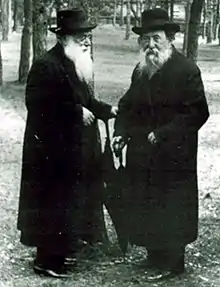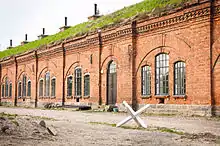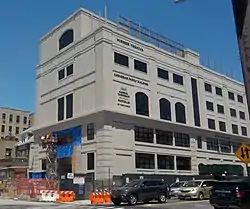Yeshivas in World War II
After the German invasion of Poland in World War II and the division of Poland between Germany and the Soviet Union, many yeshivas (Jewish schools of Torah study, generally for boys and men) that had previously been part of Poland found themselves under Soviet communist rule, which did not tolerate religious institutions. The yeshivas therefore escaped to Vilnius in Lithuania on the advice of Rabbi Chaim Ozer Grodzinski. In Lithuania, the yeshivas were able to function fully for over a year and many of the students survived the Holocaust because of their taking refuge there, either because they managed to escape from there or because they were ultimately deported to other areas of Russia that the Nazis did not reach. Many students, however, did not manage to escape and were killed by the Nazis or their Lithuanian collaborators.

Background
Before the Second World War, there were many yeshivas in Eastern Europe, mostly in what is present-day Belarus and Lithuania as well as Poland, and what was then mostly the Second Polish Republic. These include the yeshivas of Mir, Slabodka, Telshe, Radin, Lomza, Kaminetz, Kletsk, Grodno, Baranovich, and Bialystok. Thousands of students flocked to Eastern Europe from all over the world, mostly from local locations, but also from Sweden, the United States, Germany, England, Belgium, and more, to study in the famous yeshivas under venerable rosh yeshivas.[1][2][3][4]
Escape to Vilnius
At the outbreak of World War II in September 1939, the Nazis overran Poland before partitioning it with the Soviet Union. Rabbi Chaim Ozer Grodzinski, a leader of European Torah Jewry, then sent out an urgent message to all the yeshivas that had just fallen under Soviet rule, instructing them to escape to Vilnius (Yiddish: Vilna), previously part of Poland which at that point had also fallen under Soviet rule. However, Grodzinski knew that the Russians and Lithuanians had made an agreement that they would return Vilnius to Lithuania, which had been their capital city for centuries. Many of the yeshivas, including Mir, Kletsk, Kaminetz, Baranovich, Grodno, and Radin, therefore escaped to Vilnius. Altogether, there were about 25,000 Jewish refugees in Vilnius at the time.[5][6] In an interview published by Rabbi Dov Eliach, a student recalled that the Polish refugees were warmly welcomed by the Jews of Vilnius, with many of them hosting refugees in their homes, sometimes even aiding their guests financially.[7]
Although the Prime Minister of Lithuania treated the Jews well, his government decided after a few weeks that having the capital city packed with refugees was an unsustainable situation, and so the yeshivas were ordered to scatter throughout the nearby towns. The Kaminetz yeshiva relocated to Rasein;[8] the Mir yeshiva to Keidan; the Radin yeshiva to Eishishok; the Kletsk yeshiva to Yanov; the Baranovich yeshiva to Troki, and later Smilishoki;[9] the Bialystok yeshiva of Novardok to Birzh; and the Pinsk yeshiva of Novardok to Wilkomir.[10] The exiled yeshivas were supported by the American Jewish Joint Distribution Committee and the rabbinate in America.[11]
Attempts to escape Europe


The refugees in Lithuania knew that staying where they were in Europe was not a permanent solution, as they were situated between two warring nations, with Nazi Germany to the west and the Soviet Union to the east. The Vaad Hayeshivos ("The Council of Yeshivas", an organization in Eastern Europe led by Grodzinski that helped support the region's yeshivas) worked to supply all the yeshiva students with visas and passports that they would need to escape Europe for Japan and Curacao. Japanese consul Chiune Sugihara issued visas to refugees, against his country's orders.[12] The visas for Curaçao were issued by the Dutch consul Jan Zwartendijk. It was actually not a real visa, but a note in the passport that no visa was required for Curaçao.[13] For many of the students, the visas were insufficient: they needed to cross Russia to Japan on the Trans-Siberian Railway, and tickets cost $170, money which many of them did not have (according to Rabbi Dov Eliach's interview with an alumnus of the Kaminetz Yeshiva).[14]
The nasi (president) of the Mir yeshiva, Rabbi Avraham Kalmanowitz, went to the United States, understanding that he would be able to help the Jews in Europe much more from there. He was one of the heads of the Vaad Hatzolah in America,[15] and collected money to help his yeshiva. Rabbi Shlomo Wolbe, who was in Sweden at the time, and Mike Tress from the United States, also helped collect the funds. In the end, virtually the entire Mir yeshiva was able to escape Europe via the Trans-Siberian Railway to Vladivostok, and from there to Kobe, Japan. The yeshiva, together with many other Jewish refugees who managed to escape to the east, was later transferred to Shanghai, where the Japanese interned them in a ghetto. Kalmanowitz continued sending money to them. Fragments of the Polish Hasidic Chachmei Lublin Yeshiva also managed to escape to Japan and then China, and studied in the same beth midrash (study hall) as the Mir students.[16]
The many students who remained in Lithuania continued their escape efforts, attempting to travel to America. Although Vilnius had originally been given by the Soviets to Lithuania, the Soviets soon took over the entire region in 1940. When the Russian government found out that the yeshiva students were attempting to leave for America, they began to view the students as anti-Communist and against the Soviet Union. They therefore did not want them so close to the war front, lest the Germans invaded Russia and the yeshiva students joined sides with them (as the Nazis were intent on wiping out European Jewry, the yeshivas would not have joined them anyway). They therefore made plans to deport the students to Siberia. However, Russian soldiers had been commandeering Jewish homes in Lithuania, and when the hosts got wind of the situation, they warned the yeshiva students of the government's plans. Many of the students went into hiding to avoid the deportation, while other felt it would be safer for them in Siberia than to be so close to the Nazi front. In the end, many of the yeshiva students, including those from the Kaminetz, Radin, and Bialystok yeshivas, were sent to Russia, although not all to Siberia. While some, including students from Novardok and their teacher, Rabbi Yehudah Leib Nekritz,[17] and future-rabbi Yaakov Galinsky,[10] were indeed sent to Siberia, others (as published in the book Tales of Devotion in the name of a student) were taken to the remote Komi Republic at the foot of the Ural Mountains where they were subjected to forced labor.[14]
The Holocaust

According to the book Tales of Devotion, mere days after the yeshiva students' deportation to the Komi Republic, the Nazis invaded Lithuania. The students who had stayed behind hoping for safety were ultimately killed by the Nazis.[7]
The Telshe yeshiva was located in the city of Telšiai (Yiddish: Telshe) in Lithuania, and was therefore relatively already safe when World War II broke out. However, plans were made to move the yeshiva to the United States, and Rabbi Elya Meir Bloch and Rabbi Chaim Mordechai Katz traveled to America to arrange the transfer.[18] The yeshiva, led by Rabbi Avraham Yitzchak Bloch, continued in Telshe. While the rosh yeshiva's daughter and son-in-law, Rabbi Baruch Sorotzkin and Rebbetzin Rochel Sorotzkin, fled to Japan, Rabbi Avraham Yitzchak Bloch remained in Lithuania with his students.[19] All of the remaining yeshiva students as well and the rosh yeshiva were killed by the Nazis soon after.[20]
The members of the Kelm Talmud Torah, also already located in Lithuania since before the outbreak of World War II, were also massacred in the Holocaust, along with the rest of the city's Jewish population. Rounded up on July 29, 1941, the Jews were marched to the forest on the outskirts of the city to be murdered. The yeshiva's mashgiach ruchani, Rabbi Doniel Movshovitz, was forced to lead the Jews, with his brother-in-law Rabbi Gershon Miadnik, holding a sefer Torah, and the city's rabbi, Rabbi Kalman Reinishovitz, alongside him. They were then forced to dig graves. Before being killed, Movshovitz received permission to speak to everyone, and afterwards, they were all shot.[21]
In the town of Slabodka, on June 25, 1941, the Kaunas pogrom broke out, during which thousands of Jews were murdered. It was around this time that the entire Slabodka yeshiva was wiped out, with 108 students and teachers killed in a single week.[22] Many were killed in the Seventh and Ninth Forts, where Lithuanian Nazi collaborators murdered thousands of Jews. Rabbi Elchonon Wasserman of Baranovich and Rabbi Avrohom Grodzinski of Slabodka were murdered around that time too, in the Seventh Fort.[9] The members of the Ponovezh Yeshiva were all killed by the Nazis as well.[23] The rosh yeshiva, Rabbi Yosef Shlomo Kahaneman, was in Palestine at the time.[24]
Outside of Europe
While the yeshivas affected the most were located in Europe, the yeshivas in Mandatory Palestine and the United States were affected as well. In 1942, Nazi general Erwin Rommel and his army conquered North Africa and planned to advance further into Palestine. All the Jews in the region, which included the students of the Chevron Yeshiva, Yeshivas Eitz Chaim, and Yeshiva Porat Yosef, were terrified of succumbing to the Holocaust. In the end, the British defeated Rommel in the Battle of El Alamein in Egypt.[25]
The United States was also affected by the war. In 1940, Zeirei Agudath Israel founded a night yeshiva for young Jewish refugees from Europe. Headed at first by Rabbi Gedalia Schorr and later by Rabbi Shlomo Rottenberg, its teachers included Rabbi Berel Belsky (father of Rabbi Yisroel Belsky), Rabbi Simcha Wasserman, Rabbi Shachne Zohn, and Rabbi Yaakov Moshe Shurkin.[26]
Reestablishment

Despite the destruction of the yeshivas in Europe, many of these institutions were re-established in the United States and/or Israel during or after World War II. The Mir yeshiva, likely the only Eastern European yeshiva to continue operating during the Holocaust, divided after World War II between a location in New York,[15] opened and led by Rabbi Avraham Kalmanowitz, and a location in Jerusalem, opened and led by Rabbi Eliezer Yehudah Finkel, who had previously served as Mir rosh yeshiva in Europe.[27]
The Telshe yeshiva was reopened in Cleveland, Ohio, by Rabbis Eliyahu Meir Bloch and Chaim Mordechai Katz.[28] The Ramailes Yeshiva was reestablished by Rabbi Yisrael Zev Gustman in New York and later in Israel.[29] The Grodno yeshiva was reestablished in Queens, where it was led by Rabbi Zelig Epstein.[30]
In Israel, the Kaminetz yeshiva was reestablished by Rabbi Moshe Bernstein and Rabbi Yaakov Moshe Leibowitz in Jerusalem, while the Ponovezh yeshiva was reestablished in Bnei Brak by Rabbi Yosef Shlomo Kahaneman.[31] The branch of the Lomza Yeshiva that had been opened in Petach Tikvah in 1926 continued functioning after the war.[31]
References
- Wolff, Ben Zion (January 20, 2019). "Part 3-Yeshiva Torah Vodaath at 100: Talmidim of the Mesivta Speak". Hamodia. Retrieved August 20, 2020.
My mother's father, Rabbi Chaim Feldberg, was also a talmid of Torah Vodaath [in the United States], and was a classmate of Harav Chaim Pinchas Scheinberg, zt'l. Rav Scheinberg went on to learn in Mir in Europe, while my grandfather went to Radin to learn from the Chofetz Chaim zt'l.
- "Rabbi Shimon Schwab". Kevarim.com. July 3, 2009. Retrieved August 20, 2020.
- "How I Got To The Mir: A conversation with Mr. Bert Lehmann, a"h". The Circle (30). May 13, 2019.
- "Rabbi Shlomo Wolbe". Breslev.com. Retrieved August 20, 2020.
- Wein, Berel (October 1990). "Hitler's War Against the Jews". Triumph of Survival (First ed.). Brooklyn, NY: Shaar Press. p. 355. ISBN 1-4226-1514-6.
- "Yeshiva.pdf - Swiss Banks Settlement" (PDF). swissbankclaims.com. Retrieved 29 September 2020.
many of the students and townsfolk escaped to Vilna...
- Eliach, Rabbi Dov (2016). "Suffering and Miracles". Tales of Devotion.
- Shapiro, Chaim (October 1980). "The Kamenitzer Partnership: Rabbi Baruch Ber Leibowitz (40 years since his passing) and Rabbi Reuvain Grozovsky" (PDF). The Jewish Observer. XV (1): 24. Retrieved 1 November 2020.
- Krohn, Rabbi Paysach (January 2007). "Kovno and Slabodka". Traveling with the Maggid (First ed.). Mesorah Publications, Ltd. ISBN 978-1-4226-0229-4.
- Eliach, Rabbi Dov (2016). Tales of Devotion.
- Wein, Berel (October 1990). "Hitler's War Against the Jews". Triumph of Survival (First ed.). Brooklyn, NY: Shaar Press. p. 355. ISBN 1-4226-1514-6.
Supported by the hospitality of the poor Jews of Lithuania and the generosity of the American rabbinate and the Joint Distribution Committee....
- "Holocaust hero Chiune Sugihara's son sets record straight on his father's story". Timesofisrael.com. The Times of Israel. May 23, 2019. Retrieved August 20, 2020.
Chiune Sugihara, who died in 1986, ignored orders from Tokyo while posted to Kaunas (then Kovno) in 1940 and helped Jews flee the Nazis...
- "Jan Zwartendijk. - Collections Search - United States Holocaust Memorial Museum".
- Eliach, Rabbi Dov (2016). "You Kept Me from Death; You Rescued Me from the Pit". Tales of Devotion. pp. 361, 362.
- Birnbam, Avrohom (2013). In the Eye of the Storm: Remarkable Vignettes Following the Pathways of the Extraordinary Life of HaGaon HaRav Avrohom Kalmanowitz, zt"l (Special ed.). Mirrer Yeshiva Central Institute.
- Mandelbaum, David A.; Fishoff, Yechiel Benzion (September 24, 2012). From Lublin to Shanghai: The Miraculous Exile of Yeshivas Chachmei Lublin. Mesorah Publications, Ltd. ISBN 9781422613122.
- Shafran, Rabbi Avi (September 16, 2020). "Trembling with Joy: We're Here and Our Lives are Meaningful". Ami Magazine. Mehulol Publications LLC. (485): 50.
- The Jewish Experience: 2,000 Years: A Collection of Significant Events (Second ed.). Shaar Press. June 2003. p. 140. ISBN 1-57819-496-2.
- Krohn, Rabbi Paysach (January 2007). "Telshe". Traveling with the Maggid (First ed.). Mesorah Publications, Ltd. pp. 83, 84. ISBN 978-1-4226-0229-4.
- "Telshe Yeshiva". case.edu. Case Western Reserve University. 5 February 2019. Retrieved 29 September 2020.
With the German invasion of Soviet Union during World War II, the yeshiva closed and many of its students and teachers were killed.
- Krohn, Rabbi Paysach (January 2007). "Kelm". Traveling with the Maggid (First ed.). Mesorah Publications, Ltd. pp. 95–97. ISBN 978-1-4226-0229-4.
- Suissa, Dr. Michal Rachel. "History of the Slobodka Yeshiva: World Famous Talmudic Academy, the Knesset Israel – Slobodka Yeshiva - Between the Pogroms and the Holocaust". hebron.org.il. Hayishuv Hayehudi Chevron (Jewish Settlement of Hebron). Retrieved 29 September 2020.
- Bamberger, Rabbi Moshe (November 2015). "Architects". Great Jewish Treasures: A Collection of Precious Judaica associated with Torah Leaders (First ed.). Mesorah Publications, Ltd. p. 122. ISBN 978-1-4226-1666-6.
[R]abbi Yosef Shlomo Kahaneman...who replanted his illustrious yeshiva of Ponovezh, Lithuania to the city of Bnei Brak after the original yeshiva and community were destroyed in the Holocaust.
- Fendel, Rabbi Zechariah (2003). Charting the Mesorah: VOL. IV - The Era of the Later Acharonim. Brooklyn, NY: Hashkafah Publications. p. 88.
In 1940, while he was in Eretz Yisroel on a fundraising trip, he learned that his entire yeshiva had been destroyed, and his wife and children slain.
- Cohen, Rabbi Dov (2017). To Rise Above. Feldheim Publishers. p. 394. ISBN 9781680252705.
- Finkelman, Rabbi Shimon (November 2017). Rav Belsky. Brooklyn, NY: Mesorah Publications, Ltd. p. 84. ISBN 978-1-4226-1951-3.
- Finkel, Rebbetzin Sara; Heimowitz, Yehuda (March 2012). "Mir Yerushalayim". Rav Nosson Tzvi Finkel: The Beloved Rosh Yeshivah of Mir. Mesorah Publications, Ltd. p. 180. ISBN 978-1422611937.
In 5704/1944, Rav Leizer Yudel was finally ready to establish the yeshiva... Rav Isser Zalman Meltzer who had asked Rav Leizer Yudel to send his talmidim to shore up various yeshivos in Europe was now the Rosh Yeshiva of Eitz Chaim, and he returned the favor by sending a group of his top talmidim to help Rav Leizer Yudel rebuild the Mirrer Yeshiva.
- Hamodia Staff (August 17, 2020). "BD"E: Hagaon Harav Chaim Dov Keller, Zt"l, Rosh Yeshivah, Yeshivas Telshe Chicago". Hamodia. Retrieved 4 September 2020.
When the Telshe Yeshiva was established by Harav Eliya Meir Bloch and Harav Mottel Katz, zichronam levrachah, in Cleveland in 1940....
- Page, David (January 2017). Rav Gustman: The Youngest Dayan of Vilna and Illustrious Rosh Yeshivah in New York and Yerushalayim. Mesorah Publications, Ltd. ISBN 9781422618592.
- Zakon, Rabbi Nachman (June 2003). The Jewish Experience: 2,000 Years: A Collection of Significant Events (Second ed.). Brooklyn, NY: Shaar Press. p. 166. ISBN 1-57819-496-2.
The name of the yeshiva perpetuated at Shaar HaTorah in Queens, under the leadership of Reb Shimon's grandson-in-law, Rabbi Zelik Epstein.
- Zakon, Rabbi Nachman (June 2003). The Jewish Experience: 2,000 Years: A Collection of Significant Events (Second ed.). Brooklyn, NY: Shaar Press. p. 208. ISBN 1-57819-496-2.